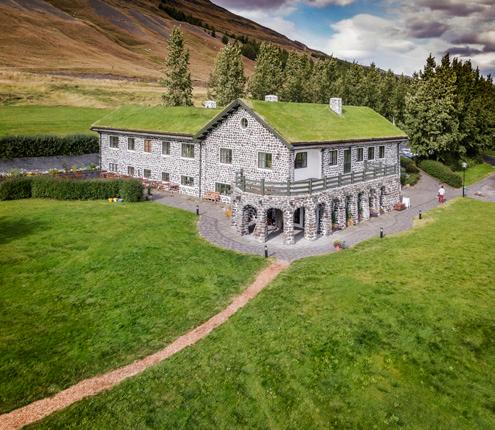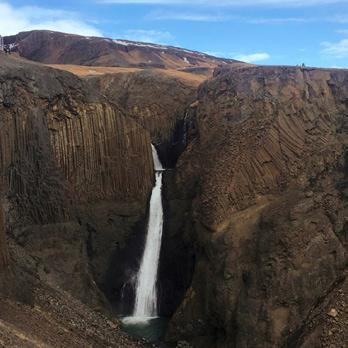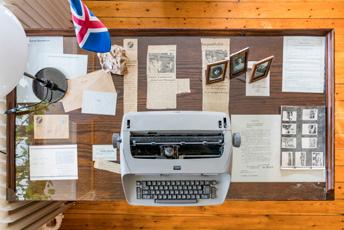
6 minute read
Hiking Hengifoss
Hengifoss, Iceland, 63° N, +15° C, 10/8, 11:59
TRAVEL East Iceland Second not secondtallest, best
Hengifoss waterfall will lure you to East Iceland, but you’ll find plenty of reasons to stay.
TEXT: Larissa Kyzer PHOTO: Ragnar Th. Sigurdsson (this spread)
As something of a waterfall enthusiast, I’ve taken many a detour when travelling around the country just to see this or that foss. Iceland is replete with waterfalls, each with its own individual character and ambiance. In Fljotsdalur valley, East Iceland, I discovered the stunningly variegated column of Hengifoss – which at 128 metres (420 feet) is the country’s second tallest waterfall – and many more natural wonders on the way.
Nice day for a walk
Fljotsdalshreppur, one of Iceland’s least populous municipalities, is characterised by a quiet, yet unassuming sort of gravitas that’s belied by its frequently stunning topographical features. In April, I was a translatorin-residence at Skriduklaustur, a magnificent turf-roofed manor that was once home to one of Iceland’s most celebrated authors, Gunnar Gunnarsson. And so, one morning, when I had no particular agenda and the weather was bright and mild, I decided to walk the 8 kilometres (5 miles) to Hengifoss.
It’s a gorgeous region, so there was plenty to see on the way. First there’s Trollkonustigur (“Giantess’s Path”), a section of which is just above Skriduklaustur. This blunt stair-stepped rock formation, or dyke, creates diagonal bands that run for 41 kilometres along the side of Valthjofsstadarfjall mountain. The broad valley down below is bisected by the churning, silty grey tail of the Lagarfljot river, and the treetops of Hallormsstadaskogur forest – the largest in Iceland – are visible on its eastern bank. Walking along the western side of the valley, I stopped to admire horses and sheep as they grazed in roadside fields, as well as a large, circular stone pen used for sorting these animals during the annual roundup. Shortly after, I passed by Tofufoss, a bewitching, tri-part waterfall fed by the Bessastadaa river, which originates high up on a mountain plateau and then plummets in successive cascades into a gorge framed by columnar basalt. It’s telling of the scope and
01 View of Fljotsdalur. Lagarfljot river is on the left. PHOTO: Gunnar Freyr Gunnarsson.
02 Litlanesfoss. PHOTO: Larissa Kyzer.

03 Skriduklaustur. PHOTO: Ragnar Th. Sigurdsson.
04 Exhibition at Obyggdasetur. PHOTO: Larissa Kyzer.
01

02 03

number of natural wonders in this area, I think, that Tofufoss is nearly always omitted from must-see lists in local tour guides.
Breath-taking ascent
Although really any view of Hengifoss is impressive, the aspect of this waterfall truly transforms depending on your vantage point. From 2.5 kilometres (1.5 miles) below in the parking lot, it’s possible to make out the iconic red clay basaltic strata that stripe the proscenium cliff walls on either side of it, but much harder to get a real sense of its magnitude. And so, although the ascent is fairly steep for much of the way, it’s worth making the effort to reach the base of the falls – weather and hiking ability allowing. Luckily, although the climb to Hengifoss sometimes left this hiker out of breath, the path is wonderfully maintained and dotted with wooden benches where you can rest and take in the magnificent valley vista. Halfway up the trail, “breath-taking” took on a whole new meaning for me when I reached Litlanesfoss, a smaller, but some say more majestic waterfall, flanked by curving pillars of columnar basalt like a sort of petrified pipe organ.
Pouring buckets
Continuing along the trail, I crossed creeks (once by bridge, other times by hopscotching over river stones) and scrabbled over boulders, sometimes losing sight of Hengifoss altogether as I wended my way up the mountain path and alongside a sheer gorge. Finally, the trail entered a wide cul-de-sac of a valley, the cliff walls striated with ancient layers of umber and red clay and punctuated by yet more trickling waterfalls. The star of the show, however, was clearly Hengifoss, whose precipitous cascade poured in giant bucketfuls into the riverbed at its base.
How close you can get to the plunge pool depends entirely on how much rain the area has gotten in recent days, but I was lucky enough to be visiting during a dry spell. So, I settled myself close enough to feel the cool spray on my face, and just sat, closed my eyes, and listened to the water tumbling, burbling, and echoing all around me.


04

Keflavik Reykjavik Egilsstadir Hengifoss
Getting there:
Air Iceland Connect offers regular daily flights from Reykjavik to Egilsstadir. From there, it’s a 35-kilometre (22-mile) drive to Hengifoss. Cars can be rented at Egilsstadir Airport.

DID YOU KNOW...
It would require 14,200 1 litre (1.8 pint) milk cartons to fill the cargo hold of the Bombardier Q400.
Cake and culture at the edge of the Highlands
East Iceland has a completely different atmosphere and landscape from the rest of the country. Here, rolling hills, verdant farmland, and dense forests take the place of sprawling lava fields and moon-surface vistas.
Some of the region’s most fascinating attractions are located close to Hengifoss. Take Obyggdasetur – the Wilderness Centre of Iceland, which is a combination of tour provider, guesthouse, restaurant, and museum, open daily from 15 May to 31 September, and by arrangement in the winter. Housed in a former 19th century farm, each of the Centre’s buildings have been refurbished with period-appropriate decor but also retrofitted with 21st century comforts (you know, like electricity and running water). Highlights include a traditional badstofa – a combination living and sleeping room where household members would gather in the evening – now a dormitory for overnight guests, and a 1940s-era farmhouse with private bedrooms and a family-style open kitchen. The Centre’s location deep within the Nordurdalur valley and on the edge of the Highlands makes it an ideal base for the diverse guided hiking, biking, and riding tours on offer, while its interactive and artfully curated historical exhibition immerses you in a bygone way of life.
Episodes from several well-known novels set in the region are recreated in the exhibition, including highlights from The Good Shepherd, a beloved Christmas tale by author Gunnar Gunnarsson. Just down the road, Gunnar’s life and legacy are celebrated in a museum established in his former home: Skriduklaustur, the site of a 15th-century monastery that Gunnar bought and had transformed into an elegant stone villa. Designed by German architect Fritz Hoger and constructed from large local river stones, Skriduklaustur took a total of 100 labourers over a year to construct, and it still has no likeness in Iceland.
Even if your interests don’t run to literary history or architecture, there’s a lot to draw you here. In 2002, an archaeological dig unearthed the ruins of the monastery, which you can walk through today, and there’s an exhibition about the history of the site in the museum as well. After you’ve absorbed enough culture, the on-site café boasts a daily cake buffet that draws people from miles around. Dig in! Skriduklaustur is open daily from 1 April to 15 October, and other times by appointment.
From Obyggdasetur. PHOTO: Larissa Kyzer. From Skriduklaustur. PHOTO: Ragnar Th. Sigurdsson.










